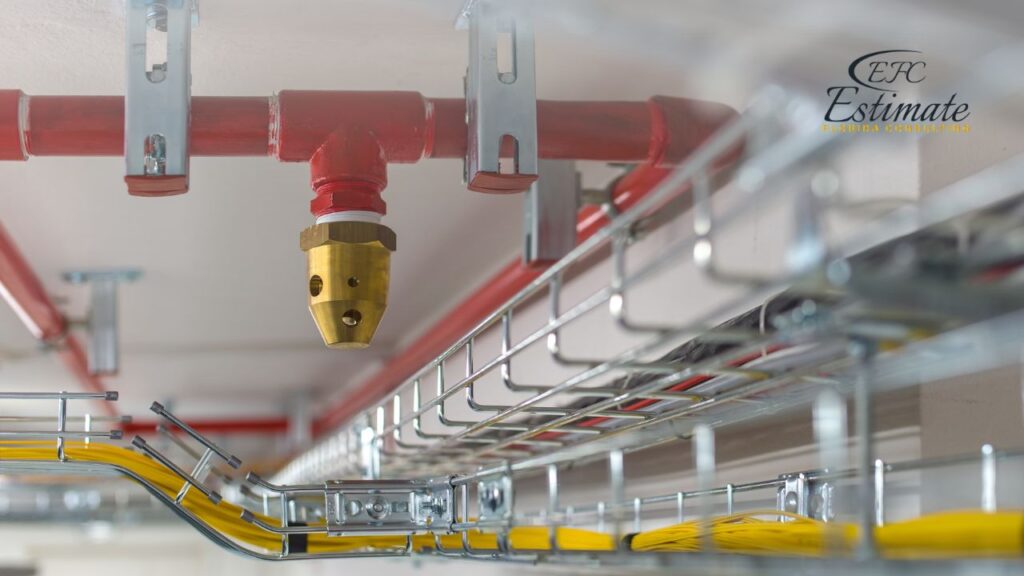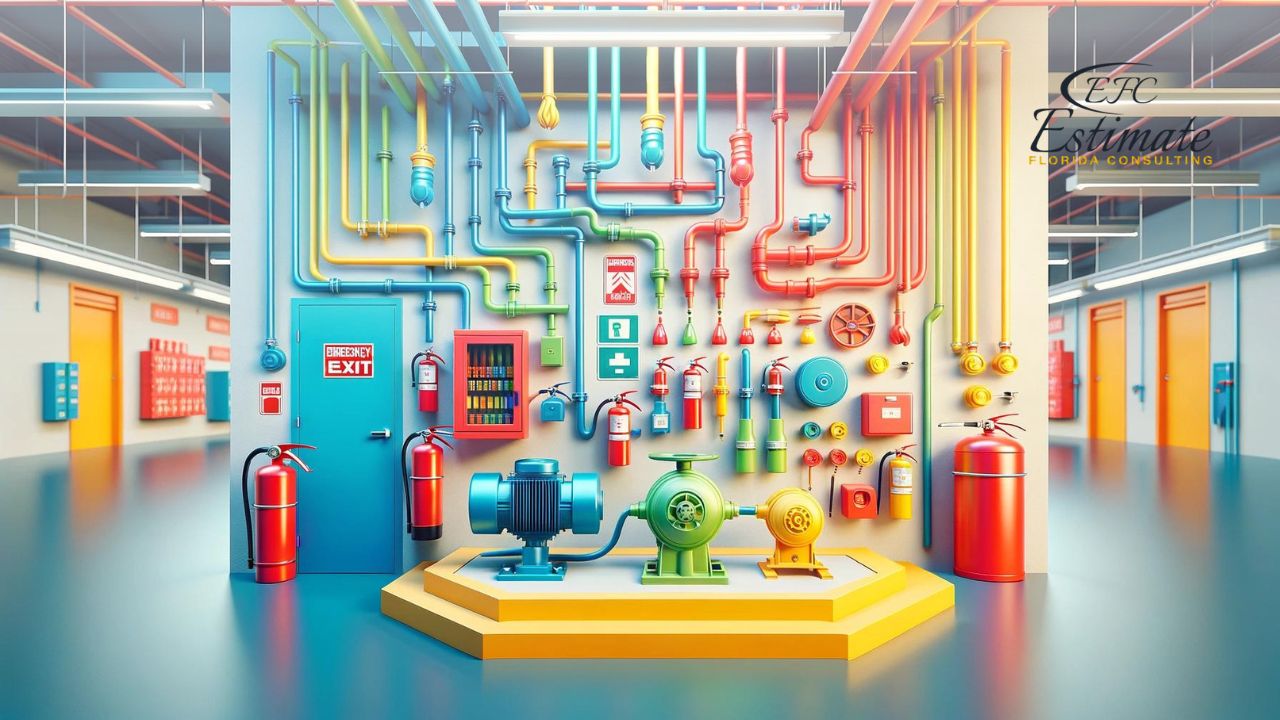Take the First Step For Estimate!
- Accurancy
- Efficiency
- Transparency
- Customization
- Time Saving
- Professionalism
- Cost Control

At Estimate Florida Consulting, our expertise lies in providing detailed cost estimates for fire protection systems tailored specifically for warehouses. Fundamental smoke detection systems may range from $8,400 to $33,600, while fire suppression systems could vary from $33,600 to $168,000, encompassing specialized options such as clean agent suppression. Emergency Power Off (EPO) systems may incur costs of $16,800 to $84,000, and advanced heat and smoke detection systems with early warning capabilities could demand $25,200 to $84,000. Structural enhancements such as fireproof barriers and doors might span from $16,800 to $84,000.

Recurring costs for maintenance and monitoring, inclusive of inspections and testing, could add $8,400 to $33,600 annually. In summary, implementing comprehensive fire protection measures in a warehouse could entail total expenditures amounting to tens or hundreds of thousands of dollars, emphasizing the necessity of collaborating with qualified professionals for tailored solutions to ensure safety.

The breakdown of fire protection components includes fire detection systems covering smoke detectors, heat detectors, and flame detectors. Fire suppression systems encompass sprinkler systems and gas suppression systems like FM-200 and CO2. Emergency evacuation systems involve exit signs, emergency lighting, and evacuation plans. Fire protection infrastructure includes fire-resistant construction materials, fire doors, and barriers. Additionally, there’s an estimated annual cost for maintenance and compliance. These elements collectively ensure comprehensive fire safety measures, essential for safeguarding lives and property in various settings.
Fire Protection Component | Estimated Cost Range |
Fire Detection Systems | $1,680 – $33,600 |
Fire Suppression Systems | $33,600 – $168,000 |
Emergency Evacuation Systems | $3,360 – $16,800 |
Fire Protection Infrastructure | $16,800 – $84,000 |
Maintenance and Compliance | $8,400 – $25,200 |
Fire protection consists of critical components focusing on both detection and suppression.
Detection systems are essential for early warning, enabling safe evacuation, while suppression systems work to contain or extinguish fires until professional help arrives. Combining both detection and suppression ensures a thorough approach to protecting lives and property from fire hazards.

Type of System | Average Costs (Material Only) |
Fire Alarm Systems | $16.80 – $84/each |
Fire Suppression Systems | $33.60 – $1,680/each |

ZIP Code Based Estimate
Highly Accurate

Fully Insured License
Hire Contractor for Warehouse

Make Informed Design Decisions Showcase Your Design Ideas
Get RenderingThe size of the warehouse is a fundamental factor in estimating the cost of fire safety equipment. Larger warehouses typically require a greater quantity of fire safety equipment to adequately cover the entire space. This includes fire extinguishers, smoke detectors, sprinkler systems, and emergency exit signage. The size of the warehouse directly influences the scale of fire protection needed, and as a result, it plays a significant role in determining the overall cost of implementing fire safety measures. Larger warehouses often require more extensive systems and equipment, leading to higher initial investment and ongoing maintenance costs.
The nature of materials stored within the warehouse is a critical consideration when estimating fire safety equipment costs. Warehouses that store highly flammable or hazardous materials, such as chemicals, fuels, or explosives, demand more advanced and specialized fire safety measures. These may include advanced fire suppression systems, explosion-proof equipment, and specialized storage arrangements. Ensuring the safety of personnel and assets when dealing with such materials is paramount, but it can significantly increase the overall cost of fire safety equipment due to the need for specialized solutions that meet the specific risks posed by the stored materials.
Compliance with local fire safety regulations and building codes is not just a legal requirement but also a factor that strongly influences the cost estimation for fire safety equipment. Different regions have varying regulations and standards that dictate the type and extent of fire protection measures required for warehouses. Failure to meet these requirements can result in penalties, legal issues, and increased insurance costs. To ensure compliance, warehouse owners and managers must consider the local regulations, which can lead to additional expenditures to meet or exceed the mandated standards.
The choice between basic and high-tech fire safety solutions has a direct impact on cost estimation. Basic solutions, such as fire extinguishers and smoke detectors, are generally more affordable than high-tech systems like advanced fire suppression systems, fire alarm systems, or automated monitoring systems. The level of protection needed and the budget allocated to fire safety equipment will influence the decision. While high-tech solutions may offer more comprehensive and sophisticated protection, they often come with higher initial costs and may require specialized installation and maintenance.

Installation costs encompass labor, materials, and any necessary modifications to the warehouse structure. The complexity of the installation process can significantly affect the overall cost estimation. Retrofitting an older warehouse with advanced fire safety systems or making structural changes to accommodate equipment can be more expensive compared to installing fire safety equipment in a new facility. The skill and expertise required for installation also contribute to the total installation cost.
Regular maintenance is a critical aspect of fire safety equipment to ensure its proper functioning when needed. Routine inspections, testing, and servicing are necessary to keep fire safety systems and equipment in optimal condition. Ongoing maintenance costs can vary based on the type and complexity of the equipment in place. Neglecting maintenance can lead to reduced effectiveness and potential failures during emergencies, underscoring the importance of factoring maintenance costs into the overall estimation.
Insurance requirements are a significant consideration when estimating the cost of fire safety equipment. Some insurance companies may have specific mandates regarding fire safety measures that a warehouse must meet to qualify for coverage. These requirements can influence the selection and installation of fire safety equipment. Failing to adhere to insurance guidelines could result in higher insurance premiums or even the denial of coverage, making it crucial for warehouse owners to incorporate compliance costs into their cost estimation process.
New projects are waiting for you.
Connect with more construction leads!

In warehouses, fire suppression systems are vital for ensuring the safety of personnel and assets. These systems come in various types, each tailored to effectively mitigate fire hazards. While some systems are standalone and require minimal installation, others, such as gas-based suppression systems or clean agent systems, necessitate professional installation for optimal functionality. Investing in appropriate fire suppression systems is crucial for safeguarding warehouse facilities and preserving operational continuity.
Type of Suppression System | Average Costs |
Fire Sprinkler Systems | $2.40 to $3.70/sq.ft. installed |
Portable Fire Extinguishers | $27.72 – $92.40/each |
Fire Blanket | $55.44 – $138.60/each |
Once the preliminary assessments are complete, the next step is the selection of fire safety components. This decision is guided by the insights gained from the risk assessment. Based on identified hazards and vulnerabilities, appropriate fire detection, suppression, and communication systems must be chosen. This selection process should also consider factors like the size and layout of the warehouse, as well as the specific needs of the occupants. Choosing the right components is crucial not only for the safety of the facility but also for cost efficiency. An inadequate system may result in higher long-term costs due to false alarms, inefficiencies, or inadequate protection.
Before embarking on any fire safety project, conducting thorough preliminary assessments is paramount. This initial phase involves delving into the specifics of the warehouse’s environment and evaluating potential fire risks. It includes a detailed risk assessment, which examines factors such as the nature of stored materials, fire-prone areas, and occupancy levels. Understanding the local building codes and regulations that govern fire safety is equally crucial, as compliance with these codes is mandatory.

These preliminary assessments not only serve as the foundation for cost estimation but also inform the design and implementation of an effective fire safety system. Ignoring this step can lead to costly oversights and inadequate protection.
Installing fire safety systems involves various considerations that can significantly impact the overall cost estimation. Labor costs, including those for skilled technicians and electricians, must be factored in. Additionally, some installations may require structural modifications to accommodate equipment such as sprinkler systems or fire alarm panels. These modifications, if necessary, can substantially increase the project’s expenses. The complexity of the installation process, which can vary based on the chosen components and the warehouse’s layout, should also be taken into account. Ignoring installation considerations can lead to budget overruns and delays in completing the project.
Beyond the initial installation, ongoing maintenance is a critical aspect of fire safety cost estimation. Regular inspections, servicing, and maintenance of fire safety systems are essential to ensure their continued effectiveness. Neglecting maintenance can result in system failures, false alarms, and potentially catastrophic consequences in the event of a fire. The costs associated with ongoing maintenance should be factored into the long-term budget to ensure that the fire safety systems remain in optimal working condition. Failing to allocate resources for maintenance can lead to higher expenses in the future, as emergency repairs and system replacements are typically more costly than routine upkeep. Therefore, recognizing the importance of ongoing maintenance is essential for both safety and cost-effectiveness.
Exploring cost reduction strategies for fire safety equipment in warehouse buildings involves balancing the need for comprehensive safety measures with budget constraints. Here are detailed strategies to minimize both initial investments and ongoing maintenance costs without compromising the safety and effectiveness of fire safety systems.

Let us take your project to the next level! Send us your plans, and we’ll provide a detailed estimate with competitive pricing. Our ZIP Code-based approach means better accuracy and a 90% higher chance of winning bids. Get personalized, no-shortcut service every time.
Ensuring proper fire safety in warehouse buildings is not only a critical responsibility but also a complex task that requires careful cost estimation and planning. This article has provided valuable insights into the factors influencing the costs of fire safety equipment, ranging from warehouse size and materials stored to local regulations and technology choices. By following the cost estimation guide and considering cost reduction strategies, warehouse owners and managers can strike a balance between safety and budget constraints. Prioritizing efficiency, compliance, and ongoing maintenance can lead to not only initial cost savings but also long-term protection for both personnel and valuable assets. Ultimately, the investment in comprehensive fire safety equipment is an investment in the well-being of employees, the protection of goods, and the preservation of the warehouse itself.
Fire detection systems in warehouses, including smoke detectors, heat detectors, and flame detectors, can range from $1,680 to $33,600.
Fire suppression systems, such as sprinkler systems and gas suppression systems, typically range from $33,600 to $168,000, with specialized options like clean agent suppression.
Emergency evacuation systems, including exit signs, emergency lighting, and evacuation plans, may incur costs ranging from $3,360 to $16,800.
Fire protection infrastructure enhancements, such as fire-resistant construction materials, fire doors, and barriers, might span from $16,800 to $84,000.
Recurring costs for maintenance and compliance, including inspections and testing, can add $8,400 to $25,200 annually.
Here I am going to share some steps to get your fire safety equipment cost for warehouse buildings estimate report.
You can send us your plan on info@estimatorflorida.com
Before starting your project, we send you a quote for your service. That quote will have detailed information about your project. Here you will get information about the size, difficulty, complexity and bid date when determining pricing.
Our team will takeoff and estimate your project. When we deliver you’ll receive a PDF and an Excel file of your estimate. We can also offer construction lead generation services for the jobs you’d like to pursue further.



561-530-2845
info@estimatorflorida.com
Address
5245 Wiles Rd Apt 3-102 St. Pete Beach, FL 33073 United States
561-530-2845
info@estimatorflorida.com
Address
5245 Wiles Rd Apt 3-102 St. Pete Beach, FL 33073 United States
All copyright © Reserved | Designed By V Marketing Media | Disclaimer